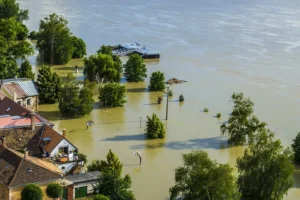Heavy rainfall continues to batter the Hunter and Mid North Coast regions of New South Wales, causing widespread flooding and prompting urgent warnings across affected areas. Rivers have burst their banks and are spilling across floodplains, putting entire communities under flood watch. As the rain tracks further south, more regions are bracing for potential devastation.
This unfolding weather disaster highlights how susceptible rural catchments and regional populations are to extreme rainfall events, especially in the wake of similar flooding earlier this year in western Queensland. The crisis serves as a crucial reminder of the different challenges faced by rural Australia compared to its urban centres during such emergencies.
 Rural regions face unique vulnerabilities
Rural regions face unique vulnerabilities
The Mid North Coast region of NSW features a mix of farmland, dense bushland, and coastal towns. Populations here are spread across rural homesteads, bushland retreats, villages, and regional centres like Taree, Port Macquarie, and the broader Hastings area. With over 100,000 people residing permanently across this region and many more arriving during holidays the spread-out nature of communities makes coordinated flood response and rescue efforts particularly challenging.
Flooding in these regions quickly disrupts road and rail networks, isolates properties, and interrupts the daily rhythm of life. Residents often find themselves cut off without warning as creeks swell and spill over, sometimes within hours of heavy rainfall.
Geography fuels fast-rising floods
The Mid North Coast is defined by short, steep catchments that empty rapidly into the ocean. Much of the region lies adjacent to the Great Dividing Range, with many rivers originating just 20 to 150 kilometres inland. These east-flowing rivers are narrow and shallow, lacking the volume capacity to store intense runoff from rainfall events.
When torrential rain hits these steep catchments, runoff is funnelled into creeks and rivers with explosive speed. As water rushes downstream, the rivers rise rapidly, overwhelming banks and inundating floodplains. Due to high soil saturation from months of preceding rainfall, water is not absorbed but rather runs off instantly, worsening flood impacts.
The results have been devastating:
- Homes, schools, and businesses are submerged
- Roads and rail links are closed or washed away
- Water and sewage infrastructure, often located on low-lying ground, is compromised
- Farm animals and pets are at risk of drowning
- Native wildlife is being displaced from bushland and waterways
- Wetlands are overwhelmed, and nutrient-rich sediment is flowing into estuaries and out to sea
Mental health challenges rise alongside floodwaters
As floodwaters continue to rise, the human cost of the disaster is becoming clear. Many residents have been forced to evacuate, some stranded and others uncertain about what the coming days hold. The emotional toll is immense, particularly in communities that have experienced repeated disasters in recent years.
Stress, anxiety, and grief are already affecting many. Support for mental health is crucial, not just during the peak of the disaster but in the months and years of recovery that follow. Emergency centres across the region have been activated, with local government agencies, NGOs, and volunteers working tirelessly to provide shelter, food, medical care, and emotional support.
It is also essential that first responders and volunteers are trained in psychological first aid to help affected individuals cope during the critical response and recovery phases.
Building resilience beyond the current crisis
While immediate rescue and relief efforts dominate the current focus, this event underscores the need for long-term strategies to reduce flood risk and build community resilience. Since the devastating 2011 floods in Queensland, national initiatives have emerged to support improved planning, infrastructure, and community preparedness for future disasters.
In collaboration with councils and supported by state and federal governments, a growing number of communities are now exploring adaptive strategies. These include:
- Constructing levees and dykes to contain river flows
- Elevating homes above known flood levels
- Implementing strict land-use planning to prevent development in flood-prone zones
- Developing community-wide flood education and awareness programs
- Creating permanent hubs to coordinate responses to floods, fires, cyclones, and heatwaves
A shared responsibility moving forward
As the emergency unfolds across NSW and pushes further south, it brings to light the urgent need for flood preparedness in Australia’s rural and regional communities. While no single solution can eliminate the risk, coordinated action between governments, local councils, engineers, scientists, and community members can reduce the impact of future events.
Extreme weather linked to climate change is no longer an isolated occurrence—it is becoming a recurring reality. Now is the time to act boldly, plan long-term, and support vulnerable communities in adapting to a new climate future.
